Corporate Law Report: Partnership, Directors' Duties and Business Law
VerifiedAdded on 2021/06/17
|9
|2468
|340
Report
AI Summary
This report analyzes key aspects of corporate law, addressing two primary questions. The first question examines the existence of a partnership among individuals involved in an internet business, considering the Partnership Act 1892 (NSW). It evaluates whether a partnership was formed based on the roles and financial arrangements of the individuals involved, particularly concerning Peta's financing and annuity payments versus Samuel and Thomas's consultancy-based compensation. The analysis references relevant case law and statutory provisions to determine if the venture satisfied the elements of a partnership: 'carrying on a business,' 'in common,' and the 'view of profit.' The second question focuses on the duties of directors, including their duties of care, diligence, loyalty, and good faith, as defined by the Corporations Act 2001. The report discusses the legal standards for directors' actions, the business judgment rule, and the consequences of breaching these duties, including civil penalties and potential disqualification. The analysis explores the importance of directors acting in the best interests of the company, avoiding conflicts of interest, and exercising reasonable care and diligence in their decision-making processes.
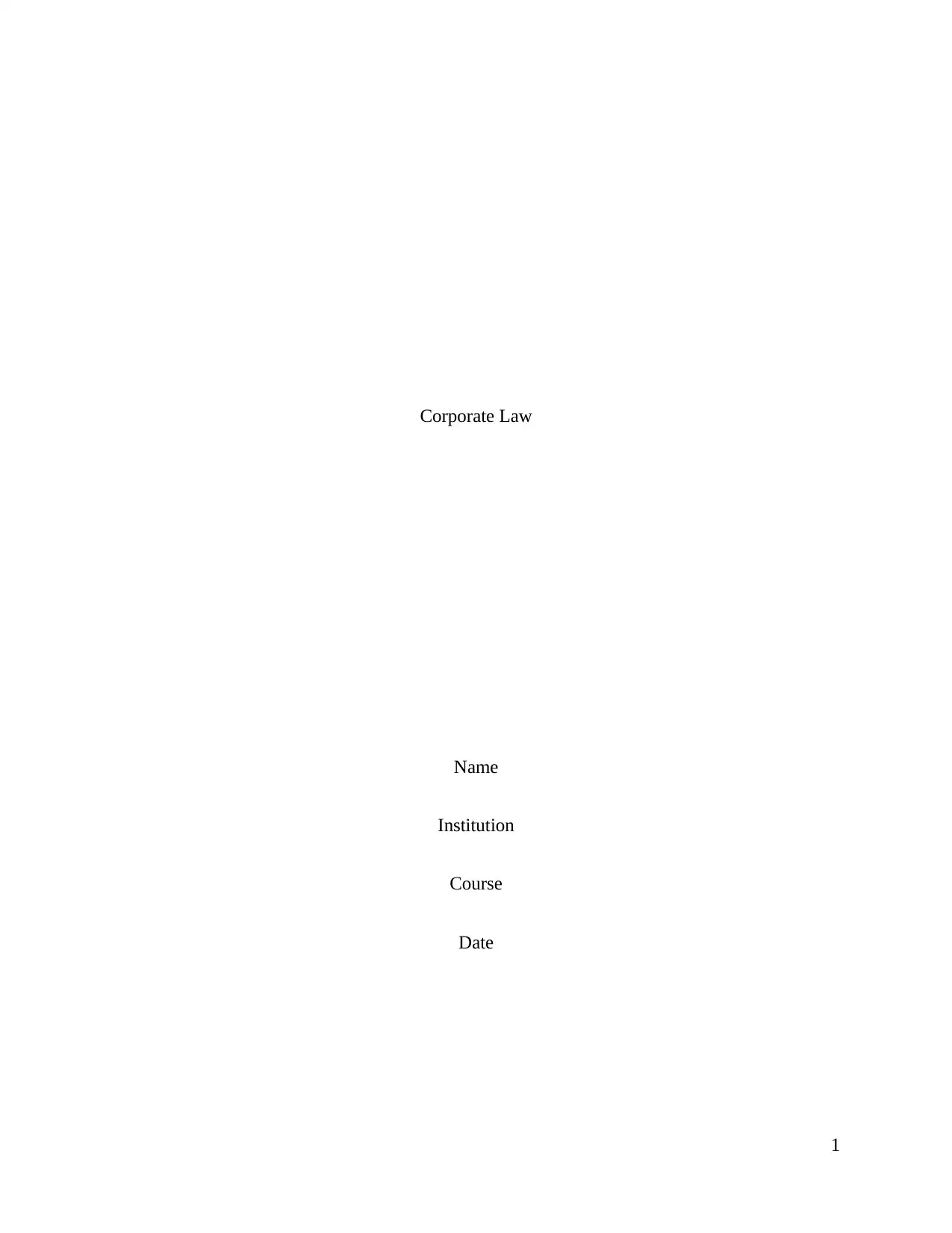
Corporate Law
Name
Institution
Course
Date
1
Name
Institution
Course
Date
1
Paraphrase This Document
Need a fresh take? Get an instant paraphrase of this document with our AI Paraphraser
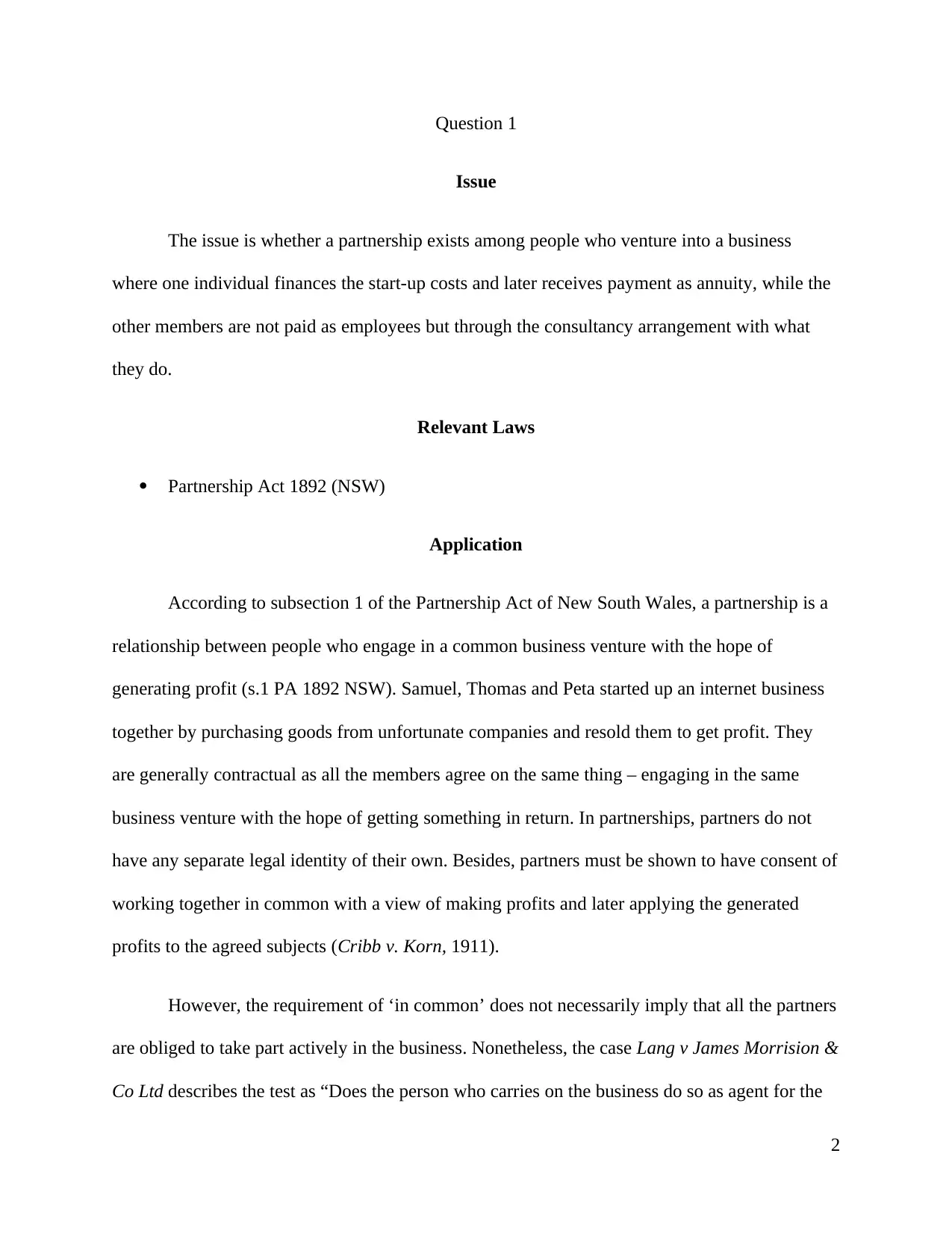
Question 1
Issue
The issue is whether a partnership exists among people who venture into a business
where one individual finances the start-up costs and later receives payment as annuity, while the
other members are not paid as employees but through the consultancy arrangement with what
they do.
Relevant Laws
Partnership Act 1892 (NSW)
Application
According to subsection 1 of the Partnership Act of New South Wales, a partnership is a
relationship between people who engage in a common business venture with the hope of
generating profit (s.1 PA 1892 NSW). Samuel, Thomas and Peta started up an internet business
together by purchasing goods from unfortunate companies and resold them to get profit. They
are generally contractual as all the members agree on the same thing – engaging in the same
business venture with the hope of getting something in return. In partnerships, partners do not
have any separate legal identity of their own. Besides, partners must be shown to have consent of
working together in common with a view of making profits and later applying the generated
profits to the agreed subjects (Cribb v. Korn, 1911).
However, the requirement of ‘in common’ does not necessarily imply that all the partners
are obliged to take part actively in the business. Nonetheless, the case Lang v James Morrision &
Co Ltd describes the test as “Does the person who carries on the business do so as agent for the
2
Issue
The issue is whether a partnership exists among people who venture into a business
where one individual finances the start-up costs and later receives payment as annuity, while the
other members are not paid as employees but through the consultancy arrangement with what
they do.
Relevant Laws
Partnership Act 1892 (NSW)
Application
According to subsection 1 of the Partnership Act of New South Wales, a partnership is a
relationship between people who engage in a common business venture with the hope of
generating profit (s.1 PA 1892 NSW). Samuel, Thomas and Peta started up an internet business
together by purchasing goods from unfortunate companies and resold them to get profit. They
are generally contractual as all the members agree on the same thing – engaging in the same
business venture with the hope of getting something in return. In partnerships, partners do not
have any separate legal identity of their own. Besides, partners must be shown to have consent of
working together in common with a view of making profits and later applying the generated
profits to the agreed subjects (Cribb v. Korn, 1911).
However, the requirement of ‘in common’ does not necessarily imply that all the partners
are obliged to take part actively in the business. Nonetheless, the case Lang v James Morrision &
Co Ltd describes the test as “Does the person who carries on the business do so as agent for the
2
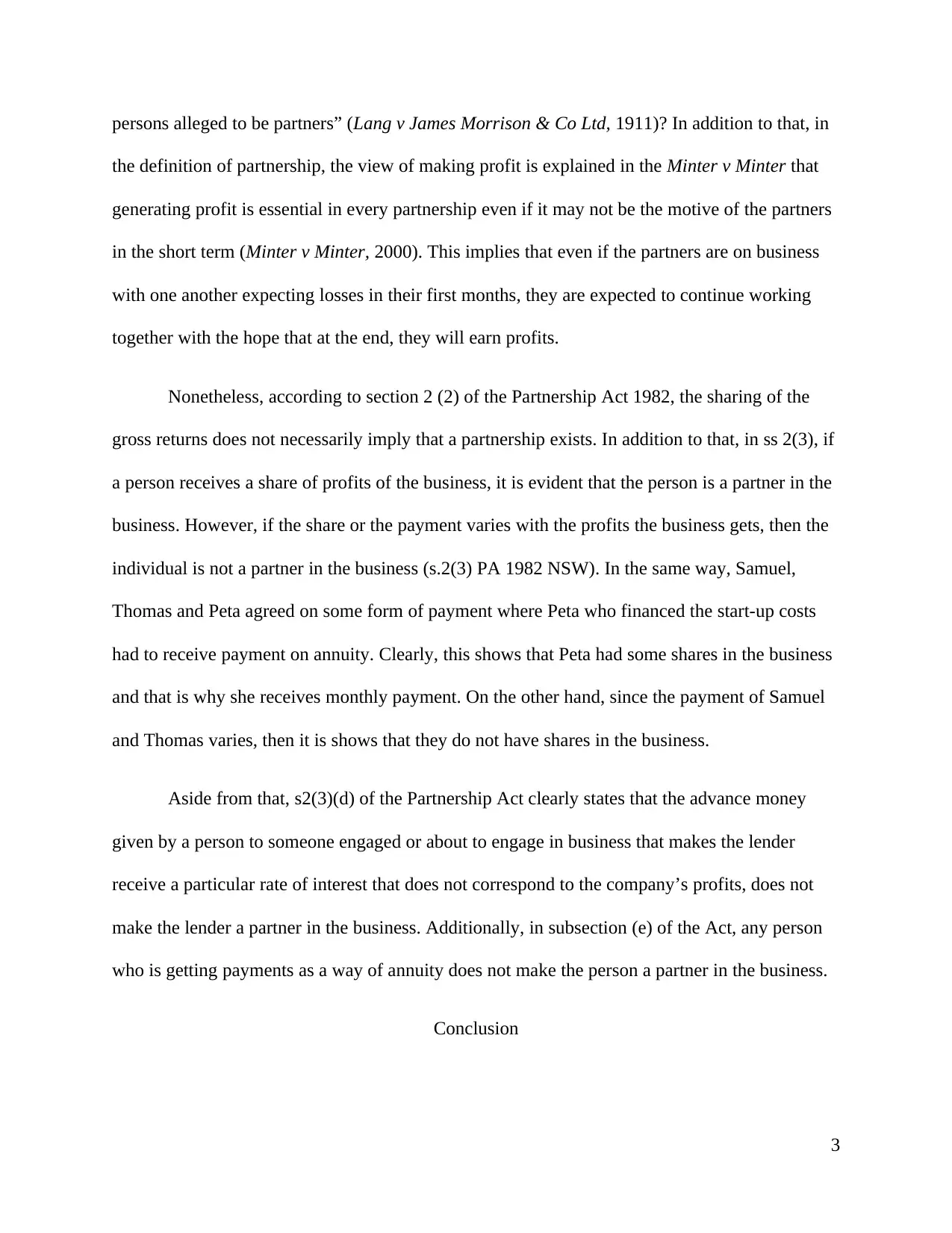
persons alleged to be partners” (Lang v James Morrison & Co Ltd, 1911)? In addition to that, in
the definition of partnership, the view of making profit is explained in the Minter v Minter that
generating profit is essential in every partnership even if it may not be the motive of the partners
in the short term (Minter v Minter, 2000). This implies that even if the partners are on business
with one another expecting losses in their first months, they are expected to continue working
together with the hope that at the end, they will earn profits.
Nonetheless, according to section 2 (2) of the Partnership Act 1982, the sharing of the
gross returns does not necessarily imply that a partnership exists. In addition to that, in ss 2(3), if
a person receives a share of profits of the business, it is evident that the person is a partner in the
business. However, if the share or the payment varies with the profits the business gets, then the
individual is not a partner in the business (s.2(3) PA 1982 NSW). In the same way, Samuel,
Thomas and Peta agreed on some form of payment where Peta who financed the start-up costs
had to receive payment on annuity. Clearly, this shows that Peta had some shares in the business
and that is why she receives monthly payment. On the other hand, since the payment of Samuel
and Thomas varies, then it is shows that they do not have shares in the business.
Aside from that, s2(3)(d) of the Partnership Act clearly states that the advance money
given by a person to someone engaged or about to engage in business that makes the lender
receive a particular rate of interest that does not correspond to the company’s profits, does not
make the lender a partner in the business. Additionally, in subsection (e) of the Act, any person
who is getting payments as a way of annuity does not make the person a partner in the business.
Conclusion
3
the definition of partnership, the view of making profit is explained in the Minter v Minter that
generating profit is essential in every partnership even if it may not be the motive of the partners
in the short term (Minter v Minter, 2000). This implies that even if the partners are on business
with one another expecting losses in their first months, they are expected to continue working
together with the hope that at the end, they will earn profits.
Nonetheless, according to section 2 (2) of the Partnership Act 1982, the sharing of the
gross returns does not necessarily imply that a partnership exists. In addition to that, in ss 2(3), if
a person receives a share of profits of the business, it is evident that the person is a partner in the
business. However, if the share or the payment varies with the profits the business gets, then the
individual is not a partner in the business (s.2(3) PA 1982 NSW). In the same way, Samuel,
Thomas and Peta agreed on some form of payment where Peta who financed the start-up costs
had to receive payment on annuity. Clearly, this shows that Peta had some shares in the business
and that is why she receives monthly payment. On the other hand, since the payment of Samuel
and Thomas varies, then it is shows that they do not have shares in the business.
Aside from that, s2(3)(d) of the Partnership Act clearly states that the advance money
given by a person to someone engaged or about to engage in business that makes the lender
receive a particular rate of interest that does not correspond to the company’s profits, does not
make the lender a partner in the business. Additionally, in subsection (e) of the Act, any person
who is getting payments as a way of annuity does not make the person a partner in the business.
Conclusion
3
⊘ This is a preview!⊘
Do you want full access?
Subscribe today to unlock all pages.

Trusted by 1+ million students worldwide
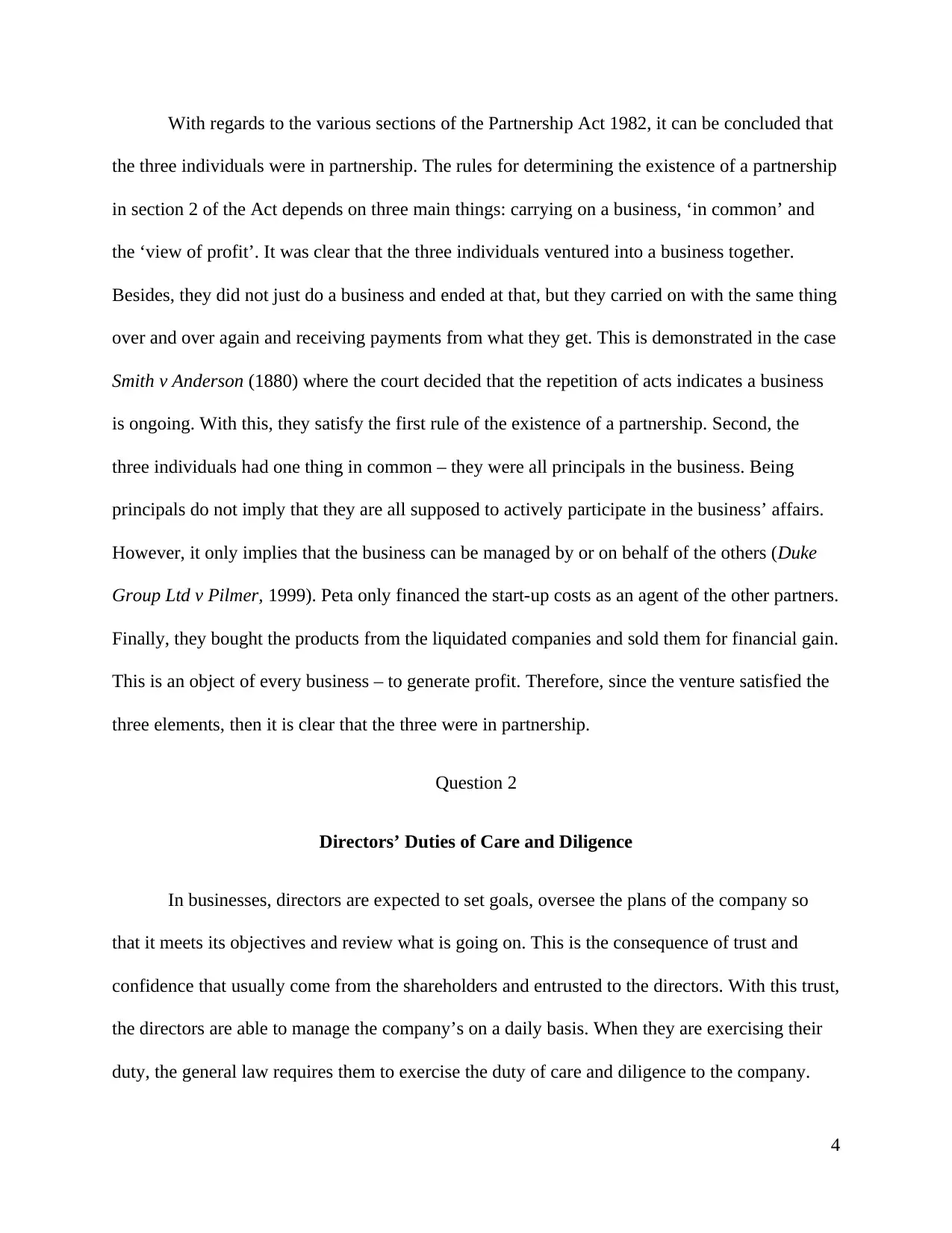
With regards to the various sections of the Partnership Act 1982, it can be concluded that
the three individuals were in partnership. The rules for determining the existence of a partnership
in section 2 of the Act depends on three main things: carrying on a business, ‘in common’ and
the ‘view of profit’. It was clear that the three individuals ventured into a business together.
Besides, they did not just do a business and ended at that, but they carried on with the same thing
over and over again and receiving payments from what they get. This is demonstrated in the case
Smith v Anderson (1880) where the court decided that the repetition of acts indicates a business
is ongoing. With this, they satisfy the first rule of the existence of a partnership. Second, the
three individuals had one thing in common – they were all principals in the business. Being
principals do not imply that they are all supposed to actively participate in the business’ affairs.
However, it only implies that the business can be managed by or on behalf of the others (Duke
Group Ltd v Pilmer, 1999). Peta only financed the start-up costs as an agent of the other partners.
Finally, they bought the products from the liquidated companies and sold them for financial gain.
This is an object of every business – to generate profit. Therefore, since the venture satisfied the
three elements, then it is clear that the three were in partnership.
Question 2
Directors’ Duties of Care and Diligence
In businesses, directors are expected to set goals, oversee the plans of the company so
that it meets its objectives and review what is going on. This is the consequence of trust and
confidence that usually come from the shareholders and entrusted to the directors. With this trust,
the directors are able to manage the company’s on a daily basis. When they are exercising their
duty, the general law requires them to exercise the duty of care and diligence to the company.
4
the three individuals were in partnership. The rules for determining the existence of a partnership
in section 2 of the Act depends on three main things: carrying on a business, ‘in common’ and
the ‘view of profit’. It was clear that the three individuals ventured into a business together.
Besides, they did not just do a business and ended at that, but they carried on with the same thing
over and over again and receiving payments from what they get. This is demonstrated in the case
Smith v Anderson (1880) where the court decided that the repetition of acts indicates a business
is ongoing. With this, they satisfy the first rule of the existence of a partnership. Second, the
three individuals had one thing in common – they were all principals in the business. Being
principals do not imply that they are all supposed to actively participate in the business’ affairs.
However, it only implies that the business can be managed by or on behalf of the others (Duke
Group Ltd v Pilmer, 1999). Peta only financed the start-up costs as an agent of the other partners.
Finally, they bought the products from the liquidated companies and sold them for financial gain.
This is an object of every business – to generate profit. Therefore, since the venture satisfied the
three elements, then it is clear that the three were in partnership.
Question 2
Directors’ Duties of Care and Diligence
In businesses, directors are expected to set goals, oversee the plans of the company so
that it meets its objectives and review what is going on. This is the consequence of trust and
confidence that usually come from the shareholders and entrusted to the directors. With this trust,
the directors are able to manage the company’s on a daily basis. When they are exercising their
duty, the general law requires them to exercise the duty of care and diligence to the company.
4
Paraphrase This Document
Need a fresh take? Get an instant paraphrase of this document with our AI Paraphraser
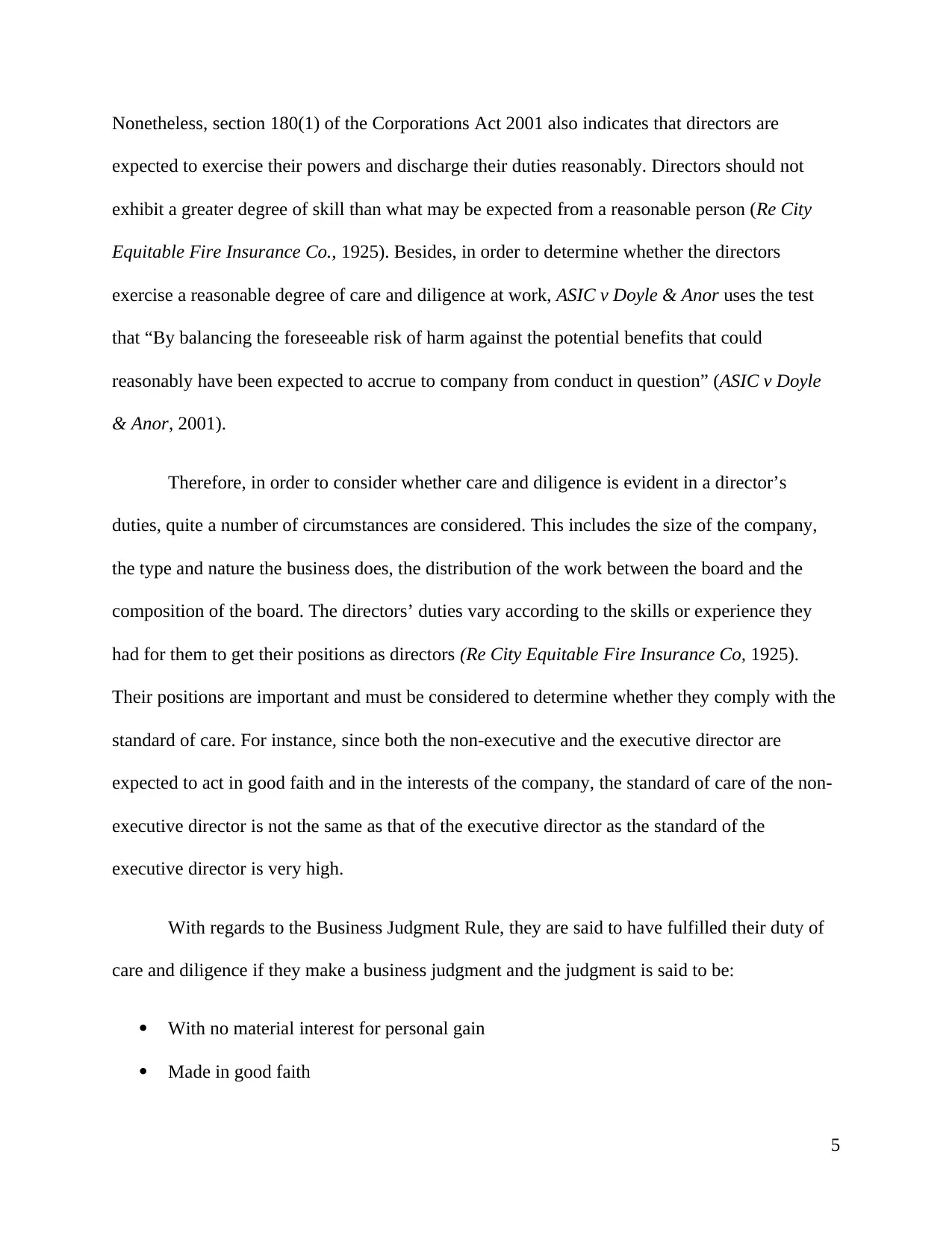
Nonetheless, section 180(1) of the Corporations Act 2001 also indicates that directors are
expected to exercise their powers and discharge their duties reasonably. Directors should not
exhibit a greater degree of skill than what may be expected from a reasonable person (Re City
Equitable Fire Insurance Co., 1925). Besides, in order to determine whether the directors
exercise a reasonable degree of care and diligence at work, ASIC v Doyle & Anor uses the test
that “By balancing the foreseeable risk of harm against the potential benefits that could
reasonably have been expected to accrue to company from conduct in question” (ASIC v Doyle
& Anor, 2001).
Therefore, in order to consider whether care and diligence is evident in a director’s
duties, quite a number of circumstances are considered. This includes the size of the company,
the type and nature the business does, the distribution of the work between the board and the
composition of the board. The directors’ duties vary according to the skills or experience they
had for them to get their positions as directors (Re City Equitable Fire Insurance Co, 1925).
Their positions are important and must be considered to determine whether they comply with the
standard of care. For instance, since both the non-executive and the executive director are
expected to act in good faith and in the interests of the company, the standard of care of the non-
executive director is not the same as that of the executive director as the standard of the
executive director is very high.
With regards to the Business Judgment Rule, they are said to have fulfilled their duty of
care and diligence if they make a business judgment and the judgment is said to be:
With no material interest for personal gain
Made in good faith
5
expected to exercise their powers and discharge their duties reasonably. Directors should not
exhibit a greater degree of skill than what may be expected from a reasonable person (Re City
Equitable Fire Insurance Co., 1925). Besides, in order to determine whether the directors
exercise a reasonable degree of care and diligence at work, ASIC v Doyle & Anor uses the test
that “By balancing the foreseeable risk of harm against the potential benefits that could
reasonably have been expected to accrue to company from conduct in question” (ASIC v Doyle
& Anor, 2001).
Therefore, in order to consider whether care and diligence is evident in a director’s
duties, quite a number of circumstances are considered. This includes the size of the company,
the type and nature the business does, the distribution of the work between the board and the
composition of the board. The directors’ duties vary according to the skills or experience they
had for them to get their positions as directors (Re City Equitable Fire Insurance Co, 1925).
Their positions are important and must be considered to determine whether they comply with the
standard of care. For instance, since both the non-executive and the executive director are
expected to act in good faith and in the interests of the company, the standard of care of the non-
executive director is not the same as that of the executive director as the standard of the
executive director is very high.
With regards to the Business Judgment Rule, they are said to have fulfilled their duty of
care and diligence if they make a business judgment and the judgment is said to be:
With no material interest for personal gain
Made in good faith
5
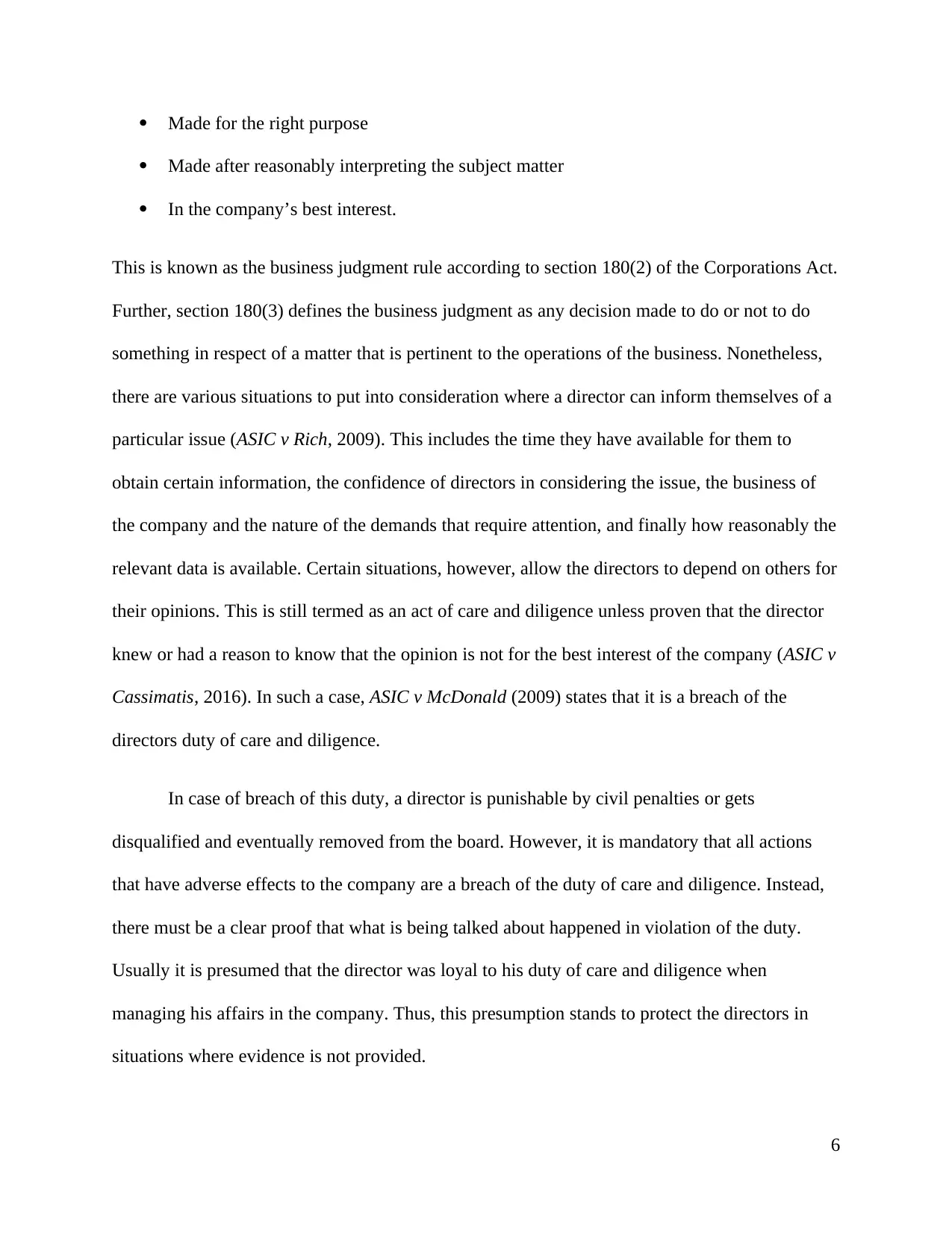
Made for the right purpose
Made after reasonably interpreting the subject matter
In the company’s best interest.
This is known as the business judgment rule according to section 180(2) of the Corporations Act.
Further, section 180(3) defines the business judgment as any decision made to do or not to do
something in respect of a matter that is pertinent to the operations of the business. Nonetheless,
there are various situations to put into consideration where a director can inform themselves of a
particular issue (ASIC v Rich, 2009). This includes the time they have available for them to
obtain certain information, the confidence of directors in considering the issue, the business of
the company and the nature of the demands that require attention, and finally how reasonably the
relevant data is available. Certain situations, however, allow the directors to depend on others for
their opinions. This is still termed as an act of care and diligence unless proven that the director
knew or had a reason to know that the opinion is not for the best interest of the company (ASIC v
Cassimatis, 2016). In such a case, ASIC v McDonald (2009) states that it is a breach of the
directors duty of care and diligence.
In case of breach of this duty, a director is punishable by civil penalties or gets
disqualified and eventually removed from the board. However, it is mandatory that all actions
that have adverse effects to the company are a breach of the duty of care and diligence. Instead,
there must be a clear proof that what is being talked about happened in violation of the duty.
Usually it is presumed that the director was loyal to his duty of care and diligence when
managing his affairs in the company. Thus, this presumption stands to protect the directors in
situations where evidence is not provided.
6
Made after reasonably interpreting the subject matter
In the company’s best interest.
This is known as the business judgment rule according to section 180(2) of the Corporations Act.
Further, section 180(3) defines the business judgment as any decision made to do or not to do
something in respect of a matter that is pertinent to the operations of the business. Nonetheless,
there are various situations to put into consideration where a director can inform themselves of a
particular issue (ASIC v Rich, 2009). This includes the time they have available for them to
obtain certain information, the confidence of directors in considering the issue, the business of
the company and the nature of the demands that require attention, and finally how reasonably the
relevant data is available. Certain situations, however, allow the directors to depend on others for
their opinions. This is still termed as an act of care and diligence unless proven that the director
knew or had a reason to know that the opinion is not for the best interest of the company (ASIC v
Cassimatis, 2016). In such a case, ASIC v McDonald (2009) states that it is a breach of the
directors duty of care and diligence.
In case of breach of this duty, a director is punishable by civil penalties or gets
disqualified and eventually removed from the board. However, it is mandatory that all actions
that have adverse effects to the company are a breach of the duty of care and diligence. Instead,
there must be a clear proof that what is being talked about happened in violation of the duty.
Usually it is presumed that the director was loyal to his duty of care and diligence when
managing his affairs in the company. Thus, this presumption stands to protect the directors in
situations where evidence is not provided.
6
⊘ This is a preview!⊘
Do you want full access?
Subscribe today to unlock all pages.

Trusted by 1+ million students worldwide
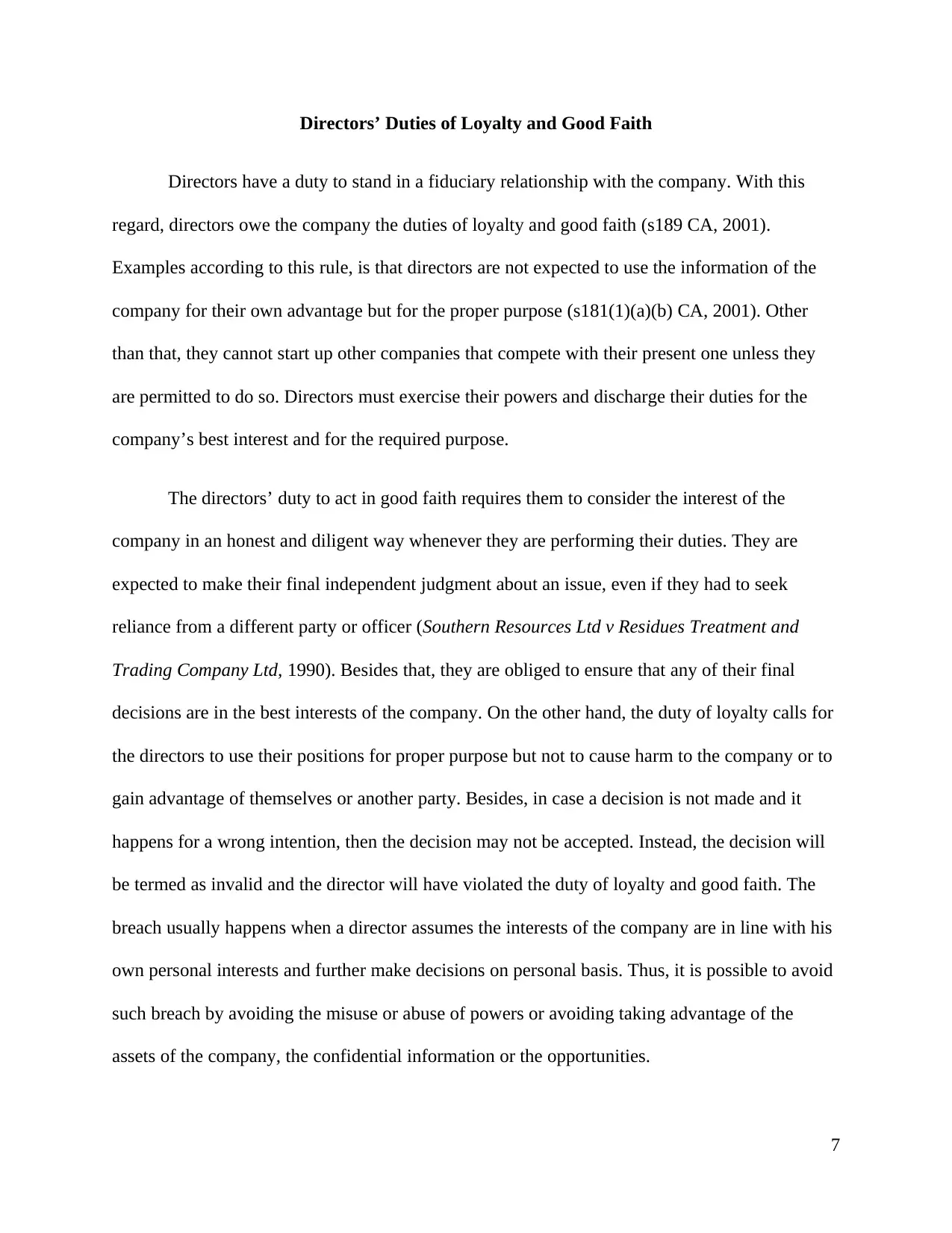
Directors’ Duties of Loyalty and Good Faith
Directors have a duty to stand in a fiduciary relationship with the company. With this
regard, directors owe the company the duties of loyalty and good faith (s189 CA, 2001).
Examples according to this rule, is that directors are not expected to use the information of the
company for their own advantage but for the proper purpose (s181(1)(a)(b) CA, 2001). Other
than that, they cannot start up other companies that compete with their present one unless they
are permitted to do so. Directors must exercise their powers and discharge their duties for the
company’s best interest and for the required purpose.
The directors’ duty to act in good faith requires them to consider the interest of the
company in an honest and diligent way whenever they are performing their duties. They are
expected to make their final independent judgment about an issue, even if they had to seek
reliance from a different party or officer (Southern Resources Ltd v Residues Treatment and
Trading Company Ltd, 1990). Besides that, they are obliged to ensure that any of their final
decisions are in the best interests of the company. On the other hand, the duty of loyalty calls for
the directors to use their positions for proper purpose but not to cause harm to the company or to
gain advantage of themselves or another party. Besides, in case a decision is not made and it
happens for a wrong intention, then the decision may not be accepted. Instead, the decision will
be termed as invalid and the director will have violated the duty of loyalty and good faith. The
breach usually happens when a director assumes the interests of the company are in line with his
own personal interests and further make decisions on personal basis. Thus, it is possible to avoid
such breach by avoiding the misuse or abuse of powers or avoiding taking advantage of the
assets of the company, the confidential information or the opportunities.
7
Directors have a duty to stand in a fiduciary relationship with the company. With this
regard, directors owe the company the duties of loyalty and good faith (s189 CA, 2001).
Examples according to this rule, is that directors are not expected to use the information of the
company for their own advantage but for the proper purpose (s181(1)(a)(b) CA, 2001). Other
than that, they cannot start up other companies that compete with their present one unless they
are permitted to do so. Directors must exercise their powers and discharge their duties for the
company’s best interest and for the required purpose.
The directors’ duty to act in good faith requires them to consider the interest of the
company in an honest and diligent way whenever they are performing their duties. They are
expected to make their final independent judgment about an issue, even if they had to seek
reliance from a different party or officer (Southern Resources Ltd v Residues Treatment and
Trading Company Ltd, 1990). Besides that, they are obliged to ensure that any of their final
decisions are in the best interests of the company. On the other hand, the duty of loyalty calls for
the directors to use their positions for proper purpose but not to cause harm to the company or to
gain advantage of themselves or another party. Besides, in case a decision is not made and it
happens for a wrong intention, then the decision may not be accepted. Instead, the decision will
be termed as invalid and the director will have violated the duty of loyalty and good faith. The
breach usually happens when a director assumes the interests of the company are in line with his
own personal interests and further make decisions on personal basis. Thus, it is possible to avoid
such breach by avoiding the misuse or abuse of powers or avoiding taking advantage of the
assets of the company, the confidential information or the opportunities.
7
Paraphrase This Document
Need a fresh take? Get an instant paraphrase of this document with our AI Paraphraser
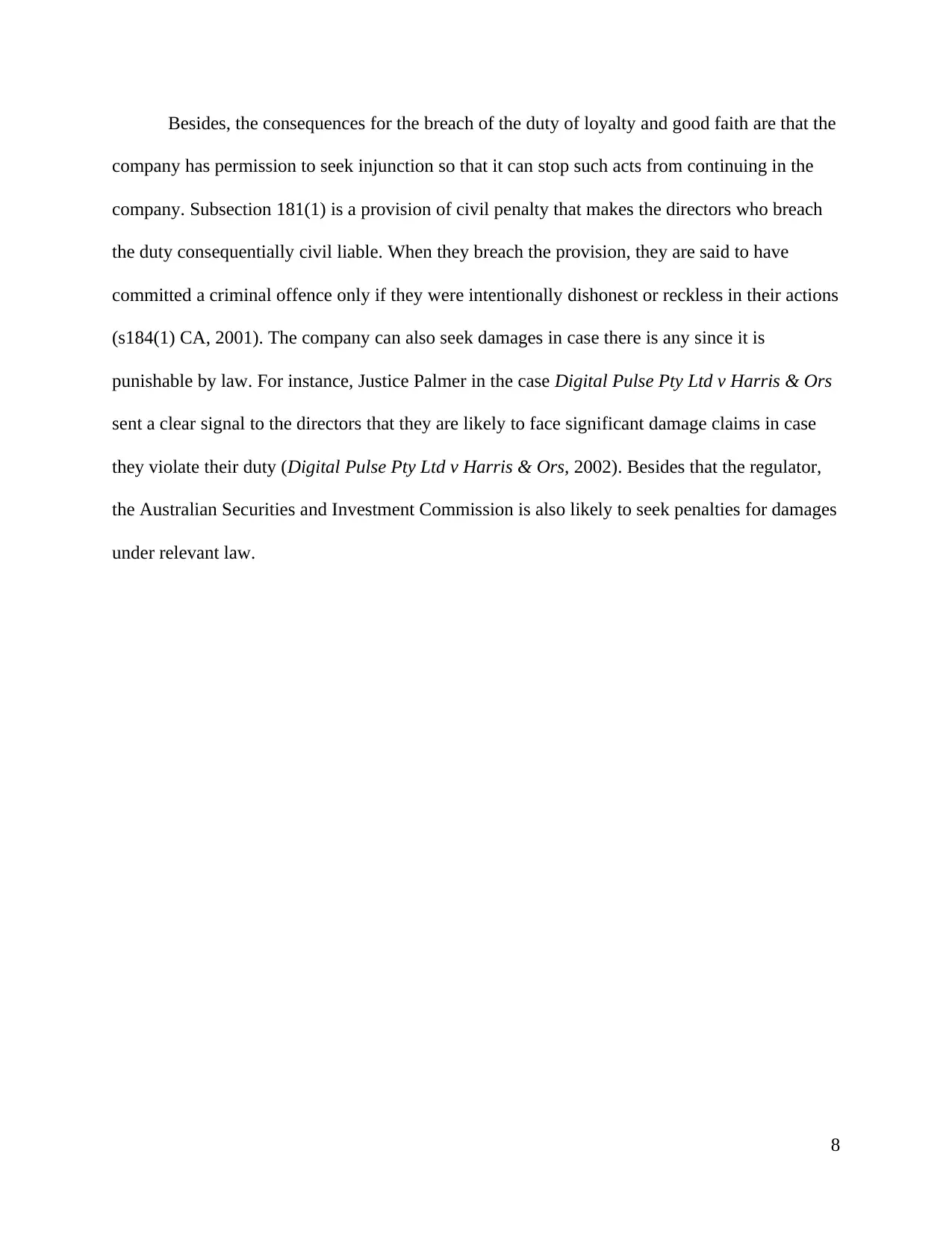
Besides, the consequences for the breach of the duty of loyalty and good faith are that the
company has permission to seek injunction so that it can stop such acts from continuing in the
company. Subsection 181(1) is a provision of civil penalty that makes the directors who breach
the duty consequentially civil liable. When they breach the provision, they are said to have
committed a criminal offence only if they were intentionally dishonest or reckless in their actions
(s184(1) CA, 2001). The company can also seek damages in case there is any since it is
punishable by law. For instance, Justice Palmer in the case Digital Pulse Pty Ltd v Harris & Ors
sent a clear signal to the directors that they are likely to face significant damage claims in case
they violate their duty (Digital Pulse Pty Ltd v Harris & Ors, 2002). Besides that the regulator,
the Australian Securities and Investment Commission is also likely to seek penalties for damages
under relevant law.
8
company has permission to seek injunction so that it can stop such acts from continuing in the
company. Subsection 181(1) is a provision of civil penalty that makes the directors who breach
the duty consequentially civil liable. When they breach the provision, they are said to have
committed a criminal offence only if they were intentionally dishonest or reckless in their actions
(s184(1) CA, 2001). The company can also seek damages in case there is any since it is
punishable by law. For instance, Justice Palmer in the case Digital Pulse Pty Ltd v Harris & Ors
sent a clear signal to the directors that they are likely to face significant damage claims in case
they violate their duty (Digital Pulse Pty Ltd v Harris & Ors, 2002). Besides that the regulator,
the Australian Securities and Investment Commission is also likely to seek penalties for damages
under relevant law.
8
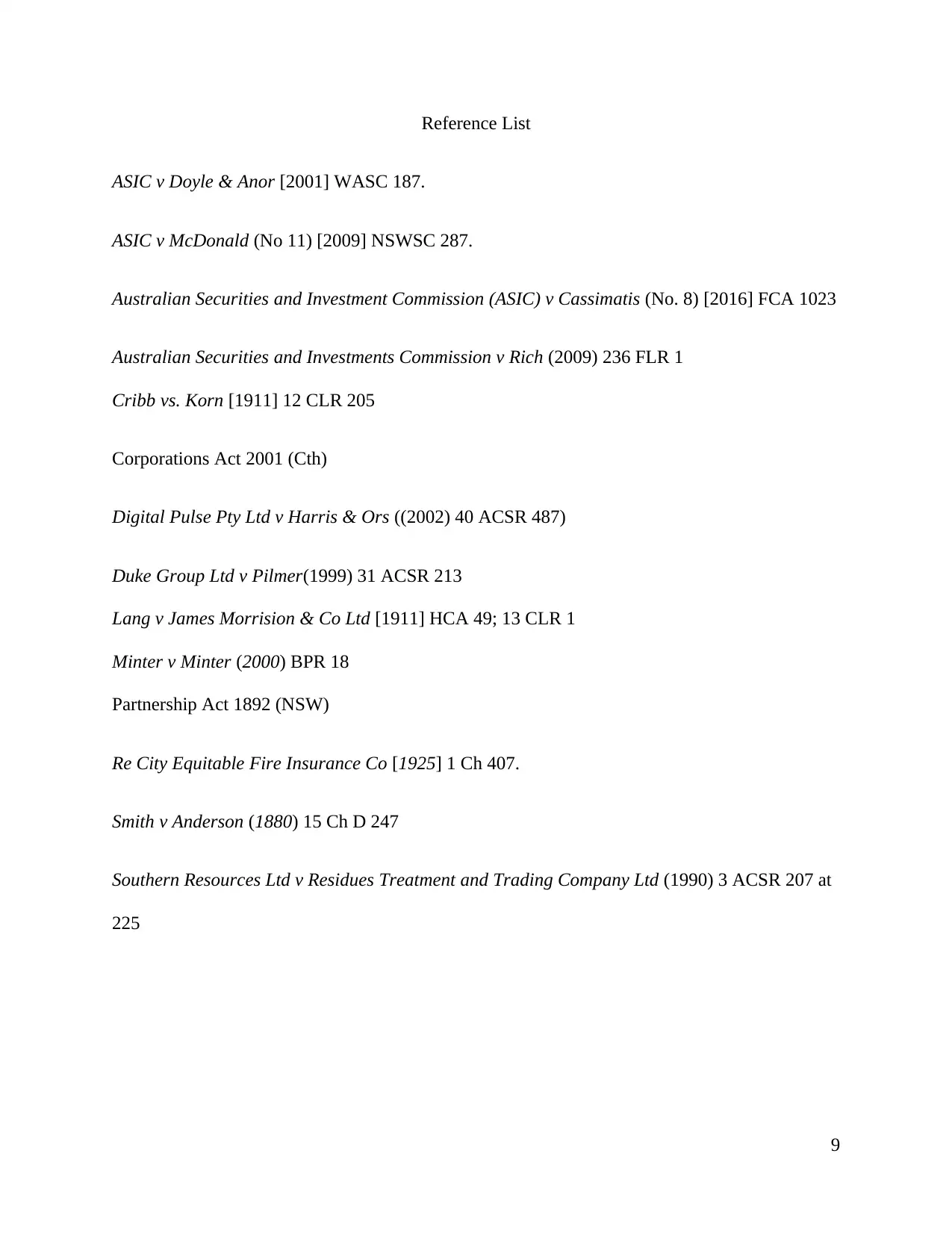
Reference List
ASIC v Doyle & Anor [2001] WASC 187.
ASIC v McDonald (No 11) [2009] NSWSC 287.
Australian Securities and Investment Commission (ASIC) v Cassimatis (No. 8) [2016] FCA 1023
Australian Securities and Investments Commission v Rich (2009) 236 FLR 1
Cribb vs. Korn [1911] 12 CLR 205
Corporations Act 2001 (Cth)
Digital Pulse Pty Ltd v Harris & Ors ((2002) 40 ACSR 487)
Duke Group Ltd v Pilmer(1999) 31 ACSR 213
Lang v James Morrision & Co Ltd [1911] HCA 49; 13 CLR 1
Minter v Minter (2000) BPR 18
Partnership Act 1892 (NSW)
Re City Equitable Fire Insurance Co [1925] 1 Ch 407.
Smith v Anderson (1880) 15 Ch D 247
Southern Resources Ltd v Residues Treatment and Trading Company Ltd (1990) 3 ACSR 207 at
225
9
ASIC v Doyle & Anor [2001] WASC 187.
ASIC v McDonald (No 11) [2009] NSWSC 287.
Australian Securities and Investment Commission (ASIC) v Cassimatis (No. 8) [2016] FCA 1023
Australian Securities and Investments Commission v Rich (2009) 236 FLR 1
Cribb vs. Korn [1911] 12 CLR 205
Corporations Act 2001 (Cth)
Digital Pulse Pty Ltd v Harris & Ors ((2002) 40 ACSR 487)
Duke Group Ltd v Pilmer(1999) 31 ACSR 213
Lang v James Morrision & Co Ltd [1911] HCA 49; 13 CLR 1
Minter v Minter (2000) BPR 18
Partnership Act 1892 (NSW)
Re City Equitable Fire Insurance Co [1925] 1 Ch 407.
Smith v Anderson (1880) 15 Ch D 247
Southern Resources Ltd v Residues Treatment and Trading Company Ltd (1990) 3 ACSR 207 at
225
9
⊘ This is a preview!⊘
Do you want full access?
Subscribe today to unlock all pages.

Trusted by 1+ million students worldwide
1 out of 9
Related Documents
Your All-in-One AI-Powered Toolkit for Academic Success.
+13062052269
info@desklib.com
Available 24*7 on WhatsApp / Email
![[object Object]](/_next/static/media/star-bottom.7253800d.svg)
Unlock your academic potential
Copyright © 2020–2025 A2Z Services. All Rights Reserved. Developed and managed by ZUCOL.


